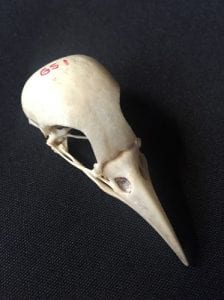Specimen of the Week 259 : Bird of Paradise
By Jack Ashby, on 30 September 2016
If natural selection can be summarised as “survival of the fittest”, how is it that some animals have evolved features that seem to be rather unhelpful to their survival? Deer antlers, peacock tails and babirusa tusks do not help an animal to stay alive. Darwin asked a similar question in The Origin of Species, and also came up with an answer – sexual selection.
Sexual selection is a sub-set of natural selection, where the driving force is not on the animal to survive, but instead to have the most descendants. It is the mechanism by which species evolve weapons that help them fight off rivals; ornaments that make them more attractive to the opposite sex; or behaviours that ensure sexual encounters result in more or fitter babies. One of the best examples of absurdly ornamented animals are male birds-of-paradise.
Feathers not Fathers
1. Female birds-of-paradise do all of the heavy lifting when it comes to producing babies – not only do they have to make the egg itself (which is millions of times bigger, and therefore energetically more costly, than the males’ investment in sperm), but they also build the nest and collect all the food for their growing chick. After their “encounter”, all a male will do is run off to try and mate with as many other females as possible, while the first female is stuck incubating the egg.
2. This means that it benefits females to be very picky about her mate. It is in situations like this, when investment in the young is really uneven, that sexual selection works most strongly. One way that sexual selection can work is to drive males to evolve characteristics that females will find attractive, and that is just what the bird-of-paradise has done.
Dancing for Dates
3. While female of these New Guinean birds are drab and brown, and generally bird-shaped (sensible naturally selected traits for keeping a low profile from predators), males have developed some of the most absurd colourings, ornamental streamers, dances and rituals of any animal.
Runaway selection
4. Sexual selection through female choice explains with how such odd features might evolve. It begins with females having a slight preference for an extravagent male trait. It might not have a selective advantage, but in some case this could give the female information about the male’s genetic fitness (for example, in order to grow and survive carrying around a giant peacock tail, the male must have avoided predators and significant parasites in his life). But as long as there is a genetic basis for the female finding the male showy trait attractive, the scene is set for that trait to develop to be even more elaborate. It’s called runaway selection – females who find males with colourful plumage attractive will mate with such a male, and so produce young that have both the male’s plumage and the female’s inherited preference for that plumage. In time, the preference creates selective pressue for even more colourful plumage, and eventually we end up with birds-of-paradise.
Skin or Skeleton: Huxley’s choice?
5. Because of the impressive nature of male birds-of-pardise’s plumage, taxidermy specimens are most commonly seen in museums. This specimen is obviously a skeleton (we are a comparative anatomy museum, and taxidermy isn’t particularly useful for that). It was Darwin who first explained the idea of sexual selection, and this skeleton once belonged to his most ardent supporter – Thomas Henry Huxley (1825-189). Perhaps Huxley wanted to look beyond the feathers and study the anatomy more closely, and so prepared it as a skeleton and not a skin. Or maybe it’s a female.
Jack Ashby is the Manager of the Grant Museum of Zoology
 Close
Close




